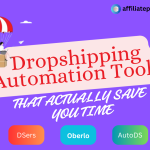Welcome to my article on “How to Track Your Affiliate Conversions Without Losing Your Mind”. Let’s be honest: nothing beats the thrill of waking up to that “You’ve earned a commission!” email. It’s the digital version of finding cash in an old coat pocket. But the real question is… where did that sale come from? Was it the blog post you wrote at 2 a.m.? The reel you almost didn’t post? Or the email you forgot even had a link? Tracking affiliate conversions shouldn’t feel like you’re cracking the Da Vinci Code—but for many new (and even seasoned) marketers, it does. Between messy dashboards, invisible clicks, and platforms that seem allergic to transparency, it’s easy to feel like you’re just guessing your way through growth. Spoiler alert: that’s not a strategy.
The good news? You don’t need a degree in data science or 16 different browser tabs open to figure it out. With the right tools and a clear game plan, you can start tracking your affiliate performance with confidence—and yes, without losing your mind in the process. In this post, we’ll break down exactly how to get a grip on your clicks, conversions, and commissions. Whether you’re a spreadsheet lover or allergic to numbers, we’ve got something that’ll work for you (and your sanity). Let’s turn chaos into clarity—one tracked link at a time.
My Best Recommended & Proven Way to Make $100-$300 Daily – Watch This FREE Video to START >>>

🧐 Understand What You’re Tracking (Clicks, Leads, or Sales?)
Before you dive headfirst into charts, dashboards, and tools that require more logins than your bank, take a breath. Affiliate tracking starts with a simple (yet often skipped) question: What exactly are you trying to track?
Here’s the thing—“conversion” is a vague term that can mean very different things depending on the affiliate program you’re in. For some, it’s a click on your link. For others, it’s a lead (like someone signing up for a free trial or filling out a form). And in the best-case scenario? It’s an actual sale where you earn actual money, not just good vibes and page views.
Let’s break it down:
- Clicks: This is the first milestone. It tells you someone was curious enough to click your link. Think of it as digital flirting. They’re interested, but they haven’t committed yet.
- Leads: These are a level up. If your affiliate program pays per lead, then someone signing up for a newsletter, freebie, or trial means cash in your pocket—even if they don’t buy anything (yet).
- Sales: Ah yes, the holy grail. This is where commissions happen. Tracking sales helps you figure out which content or channel is actually driving income—not just traffic.
Knowing which of these metrics matters most to your affiliate program (or campaign) is key. Otherwise, you’re just staring at numbers and hoping they mean something. Spoiler: they probably don’t—unless you’re clear on what success looks like.
Moral of the story? Don’t start tracking blindly. Know your goal. Because tracking the wrong thing is like celebrating a click when what you needed was a sale. (Fun? Yes. Helpful? Not really.)
📊 Use Affiliate Dashboards (But Don’t Rely on Them Alone)
Ah yes, the affiliate dashboard—that mysterious place where you log in hoping to see a commission, only to be greeted by… crickets. Or worse, “0 clicks.” Again.
Every affiliate program offers a dashboard of some kind. Amazon Associates, ShareASale, Impact, Rakuten, CJ—you name it. These dashboards track the basics: how many people clicked your links, how many sales were made, and how much money you earned. In theory, this sounds like everything you need. But in practice? Not so much.
Affiliate dashboards are like those friends who show up to your party but don’t help clean up afterward. They’ll give you the big-picture data, but they don’t tell you why something worked—or didn’t. Did the sale come from your blog post? A tweet? A random Reddit comment from 2021? The dashboard isn’t talking.
My Best Recommended & Proven Way to Make $100-$300 Daily – Watch This FREE Video to START >>>
Plus, different platforms track differently. Some update in real time, others lag by days. Some round up earnings, others round down (rude). And if you’re promoting multiple affiliate programs? Congrats—you now have five tabs open and no idea which one drove that sweet $19.99 commission.
That’s why dashboards are only step one. Use them as a reference point, not your one source of truth. Combine their data with your own link tracking tools (like Pretty Links or UTM parameters in Google Analytics) so you can see what content or platform actually made the magic happen.
In short: dashboards are helpful, but don’t expect them to hand-deliver deep insights. They’ll tell you what happened. It’s your job to figure out where and why—especially if you want to grow.
🔗 Add Click Tracking Tools to Your Workflow
Okay, let’s get real—if affiliate dashboards are the “guestimate,” click tracking tools are the truth serum. They don’t just tell you someone clicked your link… they tell you which link, where it lived, when it was clicked, and sometimes even why (well, almost).
Affiliate links can pop up all over the place—on blog posts, in email newsletters, inside Instagram bios, or tucked into YouTube descriptions. So unless you want to play detective full-time, you need a reliable way to track what’s actually driving those clicks. Enter: click tracking tools.
Here are a few tools worth adding to your tech stack:
- Pretty Links (WordPress users, this one’s for you): It cleans up those long, messy affiliate URLs into something brandable like yourdomain.com/recommends/tool. Bonus: it tracks clicks, too.
- ThirstyAffiliates: Similar to Pretty Links but with a few more affiliate-focused features like auto-linking keywords. Yes, it’s basically autopilot for links.
- Bitly: If you’re not using WordPress or you need quick, no-fuss tracking links for social or email, Bitly’s short, trackable URLs are your best friend.
Want to get a little more advanced? Use UTM parameters with Google Analytics. They let you tag links by source, campaign, and even content—so you’ll know whether that affiliate sale came from your blog post or your Tuesday email blast (and no, “probably both” doesn’t count as data).
Click tracking tools give you the missing piece your affiliate dashboard won’t: context. And when you know which links are getting love, you can double down on what’s working, ditch what’s not, and stop relying on guesswork disguised as strategy.
Because let’s face it—“I think it was from that one reel I made two weeks ago” is not the conversion analysis of a thriving affiliate business.
🌐 Track Conversions Across Platforms (Especially Social Media & Email)
Affiliate marketing used to be simple: write a blog, add some links, wait for commissions. But now? Your links are everywhere—Instagram, YouTube, Pinterest, email, maybe even that rogue tweet you forgot about. The internet is your playground… but tracking those clicks across platforms? That’s where things get messy.
The problem? Most affiliate dashboards and basic link tools aren’t built to handle the modern content jungle. Instagram bios don’t come with analytics. Emails get forwarded. TikTok’s link click data is about as clear as mud. And if you’re relying on your affiliate dashboard to figure it all out—good luck. You’ll be stuck in a maze of “unattributed” clicks and “mystery commissions.”
My Best Recommended & Proven Way to Make $100-$300 Daily – Watch This FREE Video to START >>>
So, what’s a marketer to do? Simple: bring in the big guns.
🔧 Use Dedicated Tracking Tools:
- ClickMagick and Voluum are great for multi-platform tracking. They let you build smart tracking links, set up funnels, and even track conversions from Instagram Stories, TikTok bios, and beyond.
- UTM parameters + Google Analytics: Add little tags to the end of your links (like ?utm_source=instagram&utm_campaign=summer_sale) so you can track exactly where your traffic is coming from—without guessing.
- If you’re using email platforms like ConvertKit, MailerLite, or ActiveCampaign, most allow you to track who clicked what—and when.
📥 Don’t Forget Email
Email marketing is the low-key MVP of affiliate sales, but only if you’re tracking it properly. Make sure every link is unique to that campaign. Want to get fancy? A/B test different placements: text links vs. buttons vs. image banners.
The goal here isn’t to become a data scientist—it’s to stop flying blind. With the right tracking setup, you’ll know which platform is pulling its weight and which one is just vibing in the corner doing nothing. Because once you know where the clicks and conversions are really coming from, you can focus more of your energy (and content) on what’s actually working.
No more guesswork. No more “maybe it was Pinterest?” Just clear, actionable data—and a lot fewer headaches.
📈 Analyze & Optimize: Turn Tracking Data into Action
Okay, so now you’ve got dashboards, link trackers, UTM codes, and maybe a few spreadsheets that make you feel like you’re starring in your own version of Moneyball. But collecting data is only half the battle. The real magic? Happens when you do something with it.
Let’s talk optimization—the part where you take all those pretty numbers and turn them into actual growth (and hopefully, more commissions).
🧩 Look for Patterns (Not Just Pretty Graphs)
Ask yourself:
- Which blog posts or videos consistently bring in affiliate clicks?
- Are people clicking, but not buying?
- Do your Instagram stories outperform your feed posts?
- Is one particular email sequence crushing it while the others snooze?
You don’t need a PhD in analytics. You just need to spot trends. If a certain product converts well from your email list, promote it more. If your YouTube video from last month is still getting traffic, update the description with newer links or bonuses. Use what’s working—ruthlessly.
🔁 Test, Tweak, Repeat
Affiliate marketing is not a “set it and forget it” game (sorry!). Use your data to run small experiments:
- Try different calls-to-action (CTA): “Learn More” vs. “Shop Now” vs. “See My Top Pick”
- Test link placements: Top of the page vs. middle vs. the good ol’ PS in an email
- Switch up formats: carousel post vs. reel, bullet list vs. personal story
Even the tiniest change—like moving a link 50 pixels higher—can impact click-through rates. Don’t assume. Test it. Then check your data and let it tell you the truth (even if it hurts a little).
📊 Build a Mini Dashboard or Tracking Log
Nothing fancy—just a Notion doc, Google Sheet, or Airtable board where you keep track of:
- Which links are performing
- What you changed (and when)
- What worked (and what flopped)
Why? Because your future self will thank you. Especially when something randomly spikes and you need to figure out what caused it without spiraling into detective mode.
Bottom line? Tracking data is not just for “reviewing.” It’s your growth map. It tells you what to scale, what to skip, and what to stop wasting your time on. So don’t just stare at your numbers—use them. Your commissions will thank you.
🧠 Conclusion: Make Tracking Your Superpower (Not Your Headache)
Let’s be real—affiliate tracking doesn’t exactly scream excitement. It’s not as fun as hitting “publish” on a fresh blog post, or watching your Instagram Reel go viral (shoutout to the algorithm gods). But here’s the truth: if you’re not tracking, you’re not really marketing—you’re just throwing links into the void and hoping for the best.
And we both know hope is not a strategy.
When you take control of your data—even just a little—you stop guessing and start growing. Suddenly, you know which platform is pulling its weight, which blog post is secretly crushing it, and which links are just taking up space. No more “maybe it was that tweet?” or “I think it came from my email?” vibes. Now, you’ve got receipts.
My Best Recommended & Proven Way to Make $100-$300 Daily – Watch This FREE Video to START >>>
The good news? Tracking doesn’t have to be overwhelming or soul-sucking. With a few smart tools, a little setup, and a weekly habit of checking your numbers (yes, even if you hate spreadsheets), you’ll go from stressed to strategic. From random clicks to consistent commissions. From “what happened?” to “I made that happen.”
So if you’ve been avoiding analytics like the dentist, consider this your friendly nudge. Start small. Track one thing. Then build from there. Because once you make tracking your superpower, affiliate marketing becomes a whole lot easier—and way more profitable. Now go forth and track like the data-driven boss you are. 💪💻✨
Thanks a lot for reading my article on “How to Track Your Affiliate Conversions Without Losing Your Mind″ till the end. Hope you’ve helped. See you with another article.










